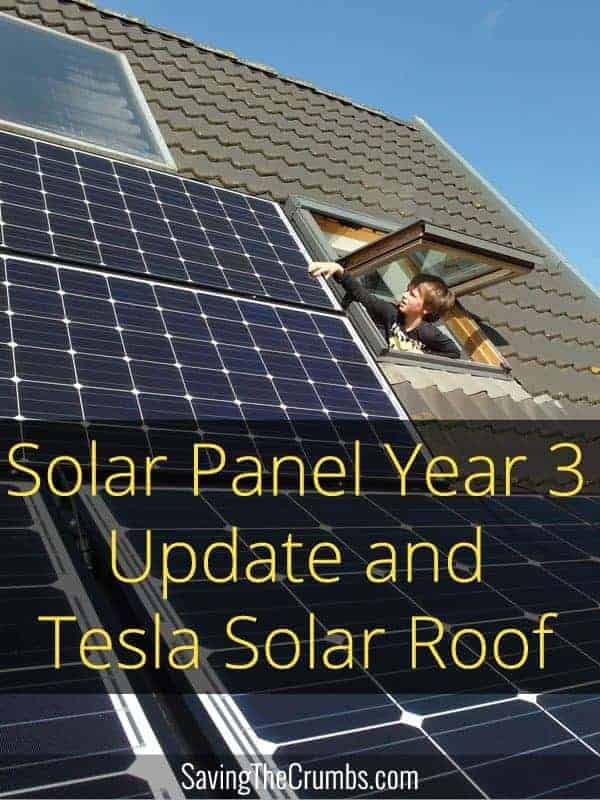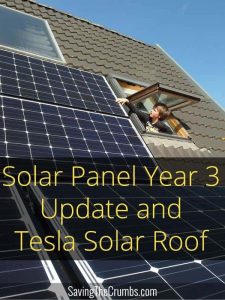Check out our previous posts if you want to follow the story from the beginning.
- How We Get Paid by Our Power Company with Solar Panels
- 1-Year Update on Our Solar Panels
- Solar Panel Update: Year 2
So how did the solar panels do in their third year of operation? Let’s take a look at the numbers.
Solar Panels Third Year Numbers
| Total Generated | Monthly Average | Annualized Rate of Return | |
| July 2016 – June 2017 | $724.99 | $60.42 | 7.6% |
| July 2015 – June 2016 | $698.72 | $58.23 | 7.4% |
| July 2014 – June 2015 | $699.46 | $58.29 | 7.4% |
Amazingly, the amount we earned from our solar panels went UP slightly this year. With solar panels expected to decrease in efficiency over time, I’ve been bracing myself for a reduction rather than an increase. It might be a one-time fluke, but I believe there are several reasons for the increase in year three.
- Electricity Rate Increase: In the past 12 months, our base electricity rate increased by approximately 0.4 cent per kWh. Since the price of the power we generate and sell back to the grid is pegged to the going rate of electricity (along with a 4 cents premium on top of that), as it goes up, so does our return. In this case, the electricity rate increase alone effectively increased our returns by around 3%. But that wouldn’t able to account for the full increase in earnings this year since 3% over last year’s earnings would still leave us under $60 for our monthly average.
- Weather Cooperation: Our area suffered through a period of drought last summer (well, as far as droughts go here in the rainy south, I suppose) and so we had more sun during many of the longer days of the year. Nevertheless, as I’ve mentioned in previous solar panel updates, summer haze, heat, and clouds (we still had plenty of all three despite the drought) can drastically reduce solar production. So while we had higher production, it wasn’t like Arizona-level production.
- Lower than Expected Panel Degradation: Our solar panels are guaranteed by the manufacturer to still be able to pump out 80% of stated capacity in 20 years. (The salesman told me that his experience was that they hold up much better than that.) In my mind, I assumed that the degradation curve wouldn’t be straight, but a bit more exponential with the greatest reduction in capacity occurring in the early years. So far, my assumption hasn’t proven correct. While I have seen some reduction of peak capacity (we used to have many days producing over 20 kWh where we seldom get those now), it doesn’t seem to be dropping off as precipitously as I had cautiously planned on. The steep drop-off might still be coming, or the salesman might be right. We shall see.
Cumulative After 3 Years
So let’s take a look at the total that we’ve earned so far in the first three years of the system.
- Cost of system: $9,500
- Total Earned: $2,143.02 (this number includes $19.85 that was earned in the partial month that the system was operational when it first went online)
- Total Return on Investment: 22.6%
- Annualized Rate of Return: 7.5%
So we are nearly a quarter of the way through paying off the original investment, and at this rate it will be about 13 years total to pay it off, not including the appreciated value of our home. As we’ve mentioned before, it’s not a jaw-dropping return by any means, but it’s worked out nicely for us since it’s a tax-free investment and one that immediately reduces our monthly cash flow needs. It’s one of the factors that enables us to have a much lower monthly budget—essential when we’re a growing family on one income.
Some Thoughts on the Tesla Solar Roof
Some of you already know that I’m a bit of a Tesla fanboy, and one who’s always keeping up with the latest innovations they’re concocting. So naturally, I’ve been very interested about their solar roof.
Seeing that I’m not in the market for a new roof anytime soon (at least I hope not!), I haven’t expended much energy in crunching my own numbers other than running through their cost estimator.
A few quick thoughts:
- Their roof is crazy expensive! With the Powerwall they recommend, we’re looking at over $54,000!
- Even with the electricity savings, tax credit, and all the assumptions that aren’t clearly shown in their estimator, it still doesn’t pay off compared to a traditional roof. The traditional roof costs only around $9,000 by their own estimate, while the net cost of the solar roof over 30 years is still nearly $17,000.
- Of course, their estimates include a Powerwall battery pack that can power the house—something that my system doesn’t have—but even with that cost removed, it still doesn’t tilt the cost in their favor enough to make it cheaper than a regular roof.
- It seems to me that if I’m looking at maximum bang for my buck, I’m much better off installing a new traditional roof and adding regular ol’ solar panels on top. Of course, it just won’t look as purdy. 🙂
- Relevantly, a footnote called “Installation Timing” offers this interesting tidbit: “Installations will start in June, beginning with California and rolling out to additional markets over time. When Solar Roof is rolled out in a particular market, Solar Roof customers will be installed based on when their order was placed.” Might be a while before they end up in Tennessee!
- Looks like no Tesla Solar Roof for me!
Obviously, this estimate is based on my location and my home. Your mileage will certainly vary. (Especially if you live in California!) But my guess is that since the Solar Roof and Powerwall are new technologies, prices will be on the decline for the foreseeable future. Perhaps when the time truly does come when I need a new roof, the prices will make more sense to consider it more seriously, and maybe they’ll be available in my state by then. In the meantime, I’ll happily continue to collect my check from the electric company every month.








